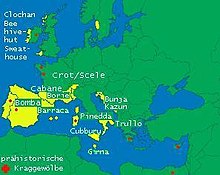Dry stone hut

Types of dry stone hut include:
- Clochán, associated with the south-western Irish seaboard
- Mitato, found in Greece, especially on the mountains of Crete
- Orri, associated with Ariège, France
- Shielings in Scotland
- Trulli, in Apulia, Italy
- stone made roundavel in sotho culture
Uses of dry-stone huts include temporary shelter for shepherds and their animals, permanent habitations for monks or agricultural workers,[1] storage and cheese making. Dry-stone huts may be thatched or roofed with sod, sometimes bound together with plant roots such as those of Madonna lily or sedum.[2]

- v
- t
- e










